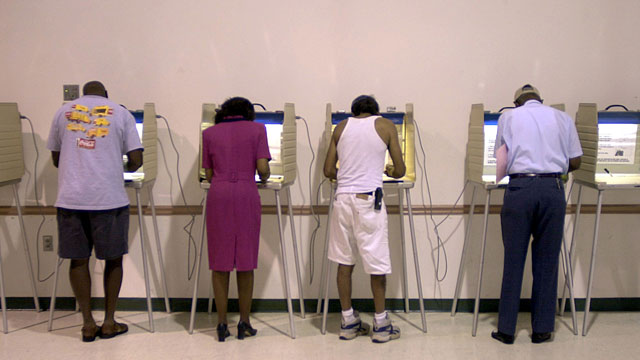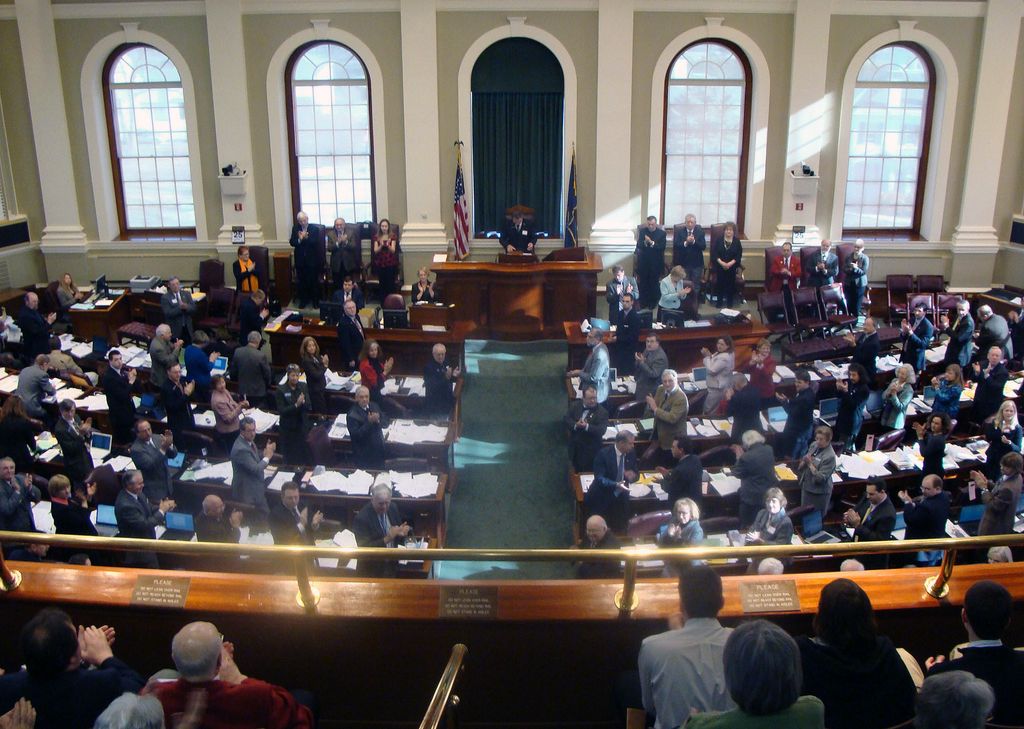Update: Voters chose all three of these ballot initiatives in the November 3 election. Seattle’s “democracy vouchers” and Ohio’s redistricting reform both won with an overwhelming percentage of the vote.

Voters mark their ballots during Florida’s primary elections. September 2002. (AP photo/Oscar Sosa)
While everyone is paying attention to the 2016 primary battles unfolding in both parties, its easy to forget that we have another election coming up this Tuesday, Nov. 3. And while we won’t be choosing our next president, in three places — Maine, Seattle and Ohio — voters will be able to weigh in directly, through ballot initiatives, on how their future elections will work.
Both Maine and Seattle’s ballot initiatives are aimed at limiting the power that special-interest donors wield in the political process. For over a decade, Maine has been cited as a prime example that publicly financing elections can work. The state’s Clean Elections Act offers public financing to any candidate who collects enough small donations to demonstrate widespread support, and who swears off large contributions. Passed in 1996 and implemented in 2000, the system worked, with the majority of Maine’s legislators opting in. But the system was undermined by two Supreme Court decisions — Citizens United and Arizona Free Enterprise v. Bennett, the latter of which went after public financing directly.

The Maine Clean Elections system grew more popular with each election cycle. By 2008, 85 percent of state legislators were using it. Photo: The Maine House of Representatives in 2009. (France in New England /Flickr CC 2.0)
With Initiative 122, Seattle’s voters will have the opportunity to implement a system of “democracy vouchers” — $25 coupons that voters would receive in the mail four times during the election cycle. Voters could “donate” the money to any candidate participating in the voucher system. The candidates who choose to participate will, in turn, have stricter spending caps (the highest, for mayoral races, is $800,000), will be required to partake in at least three public debates, and will face caps on how much private money they can accept. The ballot measure would also lower caps for how much an individual donor can give in an election, and would tighten lobbying regulation. Advocates think that the initiative will incentivize candidates to spend more time with voters, hoping to win their vouchers, and less time with well-heeled special-interest donors. Influential Seattle companies seem to agree: Microsoft and a number of other heavy hitters have mobilized money to oppose the initiative. (For more on the initiative, you may want to read this piece by Jake Horowitz at policy.mic.)
The Ohio ballot initiative takes on another scourge skewing America’s elections: redistricting. As has happened in many states, Republicans, while holding control of the governor’s office and both chambers of the state legislature in 2010, took the opportunity to carve up the electoral map, redrawing district lines in their own favor. That meant that in 2012, Republican candidates for the state’s House of Representatives got 49 percent of the vote, but won 60 percent of seats. Republicans garnered 68 percent of the votes for state senate but won 83 percent of the seats. Republicans aren’t alone in using redistricting in their favor — Illinois Democrats have been accused of doing the same thing there following the 2010 census — but gerrymandering certainly holds a more prominent place in the Republican playbook. Partisan redistricting is far easier these days than it used to be: Political operatives use mapping software, census information and voter ID data to carve up communities block by block based on political leaning.
Issue 1 on Ohio’s Nov. 3 ballot is a bipartisan compromise engineered by two retiring politicians. The initiative would add more politicians from both parties to the redistricting panel, give the minority party a greater say and encourage compromise by requiring both parties to agree on a district map. It also provides stricter guidelines for how these politicians draw districts. It’s not a perfect solution — good government advocates often push for redistricting panels to be apolitical — but it is a step in the right direction. (For more, check out this rundown from the Columbus Dispatch.)
While the spectacle of the presidential horserace has solid entertainment value, its easy to forget that the policies championed on the debate stage will likely have far less bearing on individual Americans’ lives than decisions made by lawmakers at the state and local levels. Special-interest donors certainly recognize that reality, and focus an increasing amount of their funds and lobbying muscle on statehouses. These three ballot initiatives seek to counter that trend, and are important experiments in limiting the corrupting influence of money in the post-Citizens United era. While not all of us will get to play a role in determining how they fare on Tuesday, they could provide models for our states and cities in the years to come.



